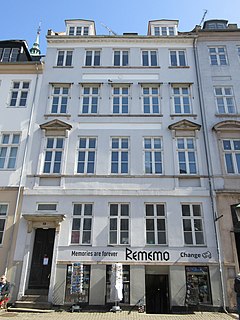Højbro Plads 17
| Højbro Plads 17 | |
|---|---|
 | |
 | |
| General information | |
| Architectural style | Neoclassical |
| Location | Copenhagen |
| Country | Denmark |
| Coordinates | 55°40′41.45″N 12°34′49.19″E / 55.6781806°N 12.5803306°ECoordinates: 55°40′41.45″N 12°34′49.19″E / 55.6781806°N 12.5803306°E |
| Completed | 1798 |
Højbro Plads 17 is a Neoclassical property situated on the east side of Højbro Plads in central Copenhagen, Denmark. The building was like most of the other buildings in the area constructed as part of the rebuilding of the city following the Copenhagen Fire of 1795. It was listed in the Danish registry of protected buildings and places in 1924.
History[]
The site was together with that of present-day No. 15 in 1689 part of a larger property (then No. 217) owned by wine vendor (vintapper) Peter Pecken. It was then situated in the no longer existing street Store Færgestræde. In 1756, it was as No.254 owned by commander Kiærulff.[1]
The building was destroyed in the Copenhagen Fire of 1795. The square was subsequently created as part of Peter Meyn's and Jørgen Henrich Rawert's plan for the rebuilding of the city. The current building was constructed in 1797-98 for clockmakerJohan Nicolaj Bath. The property was in the new cadastre of 1806 listed as No. 45 and was by then still owned by Bath.

The industrialist and co-founder of Industribanken Hans Peter Frederiksen (1810-1891) was among the residents in 1861.[2] With the introduction of house numbering by street in Copenhagen in 1859 (as opposed to the old cadastral numbers by quarter)), No. 45 became Højbro Plads 17.[1]
The building was at the time of the 1880 census home to a total of 15 people.[3]
The building was in the 1910s home to a broker's office as well as a dental clinic as advertized by large signs on the facade. (cf. the image)
Architecture[]
The building is constructed with four storeys over a walk-out basement and is five bays wide. The facade is divided horrisontally by a cornice band above the ground floor. The main entrance furthest to the left is topped by a hood mould supported by . The basement entrance is located in the second bay from the right. The outer windows on the first floor are framed in sandstone and are topped by triangular pediments. The rectangular space below the windows were originally decorated with blind balustrades (cf. the vintage photo above). The outer windows on the second floor have sills supported by corbels but no pediments. The three central bays are visually brought together by through-going sills under the windows on the second and third floors while the sill on the first floor runs in the full width of the building. A slightly recessed band under the three central windows on the third floor was originally the site of a stucco frieze (cf. the vintage photo above). The facade is finished by a modillioned cornice under the roof. A short perpendicular side wing extends from the rear side of the building. The Building was listed in the Danish registry of protected buildings and places in 1824.[4]
Today[]
The building is today owned by E/F Højbro Plads 17.
References[]
- ^ Jump up to: a b "Københavnske Jævnførelsesregistre 1689-2008". Selskabet for Københavns Historie (in Danish). Retrieved 28 February 2021.
- ^ "Højbro Plads 17". indenforvoldene.dk (in Danish). Retrieved 28 February 2021.
- ^ "Folketælling - 1880 - Højbroplads 17". danishfamilysearch.dk (in Danish). Retrieved 1 March 2021.
- ^ "Sag: Højbro Plads 15". Kulturstyrelsen (in Danish). Retrieved 28 February 2021.
External links[]
| Wikimedia Commons has media related to Højbro Plads 17. |
- Højbruplads 15 at Karberghus
- Source
- 1880 census
- Neoclassical architecture in Copenhagen
- Listed residential buildings in Copenhagen
- Residential buildings completed in 1798
- 1798 establishments in Denmark
